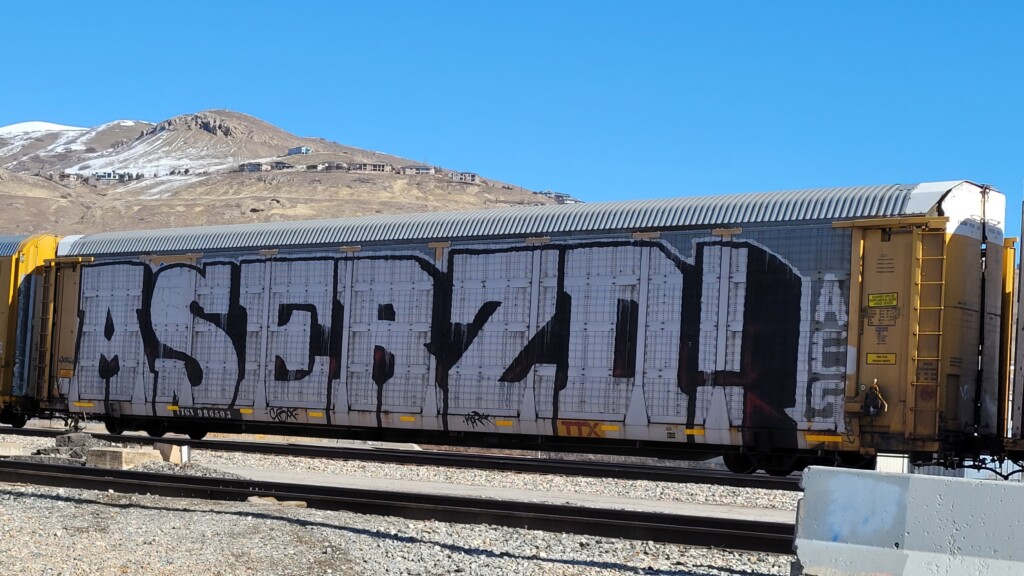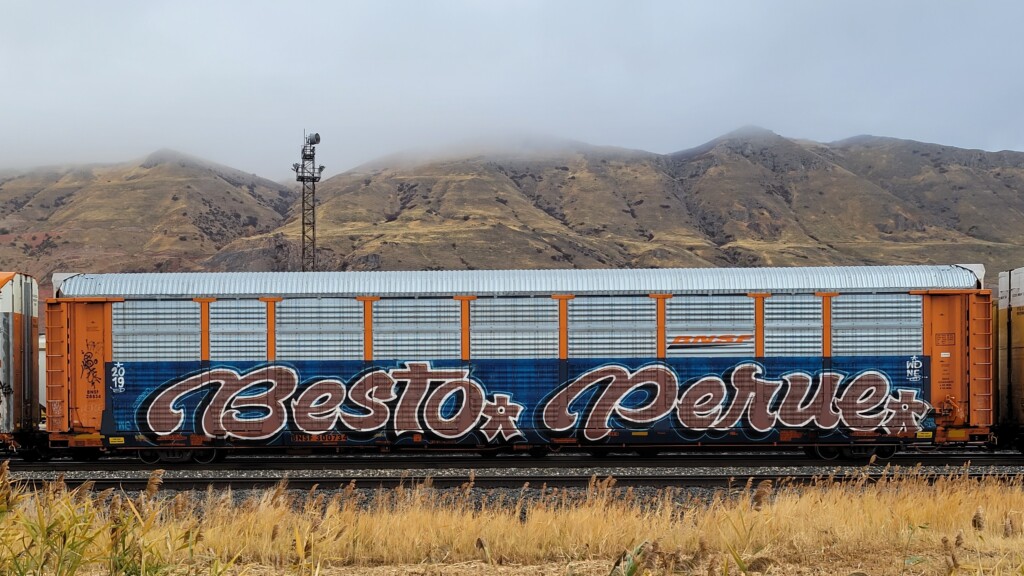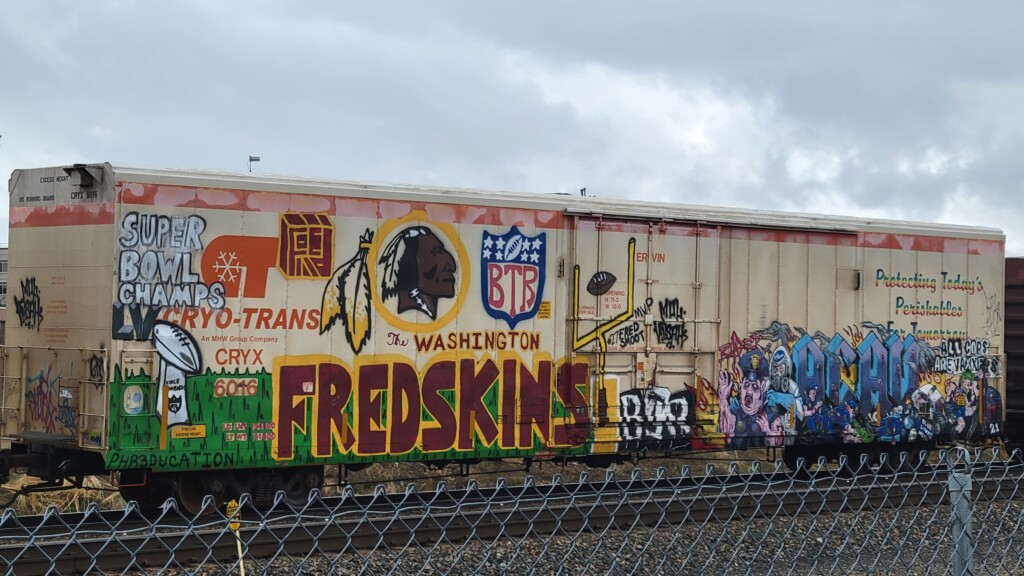The spring afternoon sun casts a flattering light in Dusk Raps’ art studio, located in his downtown Salt Lake City apartment. His work space is neat and organized, which gives the viewer a clear sense of not only his current paintings in process but also numerous examples that catalog his evolution in technique, subject matter and mixed media forms. Resting on an easel is a strong vertical canvas that has recently been started, with an image attached to the left-hand corner, which he uses as a guide. It reflects the visual aesthetics of medieval legends or religious iconography. It is reminiscent of the fantasy art that made Frank Frazetta famous, or the imagery evoked by Frank Herbert’s Dune.
The stencil lines are visible through the yellow character shape, which has a thin blue aura around it. The yellow strikes an epic presence. On the other side is a painting that is much farther in progress, which also indicates how Dusk’s style has evolved in the last several years. The lines appear more fluid, textured layers are apparent in the hues he chooses, and details pull forward the narrative character of the originating image source.
There are other works which he has recently started, with iconographic source material, some of which may become part of a collage and others as a standalone painting. Works on the wall represent Dusk’s familiar style from an earlier period, with their sharp, bold graphics and lines, cartoon characters and the essence of street and graffiti art. His most recent signature Camo Tower body of aesthetics signals another evolution in his artistic expression.
It might surprise more than a few that Dusk Raps (Ryan Worwood)’s apartment has become a full-fledged visual art studio. He has been on the local hip-hop and rap scene since at least 1996, when he graduated from Hunter High School in West Valley City. But, even during the height of Mindstate – a popular hip hop duo featuring Dusk as MC and his brother Ben as DJ Honna – many already were aware of how Dusk integrated making art with making rap lyrics and beats, especially when he was performing. “I would paint something that I could finish at the show and sometimes I stenciled it out beforehand to make it happen,” he says.
Over the years, Dusk looked for more opportunities to do art. After Mindstate, he released a debut solo album, Throw Away The Key, which dropped in 2012. Luke Mehall captured Dusk’s objective in a fine nutshell:
What is most clear in this album is that he is an artist in the truest sense of the word. (He is also a painter and graffiti artist, and the cover of the album is his own work, in his own, unique style.)
He is open, honest, and reflective; he doesn’t hide anything or try to be anything he isn’t. He clearly loves hip-hop, and each song reveals a different side. He oozes Salt Lake City through the album, and is a major player in the hip-hop community there. He raps on the song Laser Beams: “Get down for my town, so proud you can’t hate it”.
That sentiment is sharper and more generous now. Dusk has the respect deserving of, for the lack of a better description, an elder statesman in the local hip-hop community (albeit he is just in his middle forties). He also boosts the signal for Utah’s newer generation of hip-hop artists, including Dumb Luck, Zac Ivie and artists connected to Get It Write Records, a local label established by Ivie, including Earthworm, T-Mental, Titan The Quite Boi, Ocelot and ChefboyZarDeE. Dusk’s most recent recording was in 2020, with Annabelle, produced by Chance Lewis, who also played guitar and saxophone, and Bly Wallentine on clarinet.
Life as a musician included many weekends with everyone, as Dusk says, “partying their feet off.” But, now he has traded the nightlife of bars and clubs for the opportunity of painting on weekends “to get ahead.” Already this year, he had a solo show and a group show, which is currently available, at Lost Acorn Gallery in the city’s Avenues district. Dusk also has been a familiar face at the Urban Arts Festival and Craft Lake City.
He doesn’t mind the sacrifice to focus on this latest phase where he has picked up the pace of producing work that is spreading into different media forms and technique. “I have a side hustle, doing landscaping for daytime work,” Dusk explains, adding that he is suited to working alone.
This also gives him the space to explore new roots of his intellectual curiosities. He is shaping a broadened creative philosophy, gaining confidence in trying mixed media forms, disciplining himself as a high achiever and deepening his perspective about the effective process and enterprise to thrive as an independent artist.
In his landscaping job, he listens to music but he also is more likely to be listening to podcasts and audiobooks about creative motivation and examples of high achievers. The list includes biographies about musicians, artists and athletes (despite the fact that he was never interested in sports).
It includes Phil Knight’s memoir, Shoe Dog, the 2016 New York Times bestseller, about how Knight founded Nike and its rocky days as a startup. As with other astute creative entrepreneurs, Dusk has absorbed the cross-pollinating epiphanies from such stories, including those of Kobe Bryant and Mike Tyson.
The takeaways for Dusk are straightforward. “Work hard and be yourself,” he explains. “I realized that it is possible to have a pretty spartan existence and hope to work as little as possible but also to make it all about how I focus. The stories that inspire me are about tenacity. So, I’m happy to sit and paint at home and build up a cushion so I don’t have to worry about where my next meal is coming from.”
Along with skateboarding in his boyhood, music and art steadily gained a large portion of Dusk’s radar. He would draw skulls, swords and weird cartoon faces. He liked the aesthetics of sharp graphic and graffiti designs, cartoons, movie posters and CD box covers.
He would listen to Top 40 tunes on the radio and record them from the broadcast. KRCL-FM carried a late night rap show every Friday that also fed his muse. Many of those artists from the late 1980s and 1990s he heard from his elementary school days are still part of Dusk’s listening rotation, including LL Cool J and Big Daddy Kane.
One of his favorite songs is a 1964 classic by Otis Redding, These Arms Are Mine, a ballad that many consider to be the best example of how Redding poured his soul into his music. Another is Ice Cube’s Steady Mobbin’ (a phrase that Dusk likes as his own mantra), which inspired Dusk to write lyrics for Yung O’Shea, a 2016 collaboration with beats by Big Yuh and production by Chance Lewis.
Dusk recalls that during his childhood, when the county library bookmobile came to West Valley City, he could find recordings of rap artists, including the series of budget compilation albums by Priority Records featuring rap masters that were released between 1988 and 1996.
By the time he was a senior in high school, Dusk already had joined the local hip hop scene, encouraged by the DIY aesthetic of the community and how graffiti and rap styles were blended. He admits that he was a slacker during school but he still needed enough credits for graduation so he decided to take an art class. However, he ended up in an Advanced Placement art course, even though he was not planning to go to college.
It turned out well. He found the teacher to be the right fit for what he wanted to accomplish. “He knew my dad and they used to work together,” Dusk recalls. Apparently, his teacher initially went to college to study accounting but then he shifted gears toward art. The class experience whetted Dusk’s appetite. He enjoyed sitting in his room at home and drawing. But, he was less than enthused by his art classes at Salt Lake Community College. “They were more academic and it sounded like a lot of rules needed to be followed,” he adds.
From that point, Dusk embarked on his own course to build the creative foundation he envisioned. One book that resonated with Dusk’s preference for getting straight to the point was Steven Pressfield’s The War of Art: Break through the Blocks and Win Your Inner Creative Battles (2002).
Another was the fantasy world that Frank Herbert constructed in his 1965 book Dune, which also would be adapted to film in 1984 by director David Lynch (who actually would disavow the film). The film was a flop, both critically and financially, but, nonetheless, its blending of digital technology with contemporary and medieval tropes of dynasty, mysticism, heroic legends and stark desert landscape propelled Dusk’s ongoing search for his own muse.
His source materials for inspiration have expanded greatly. Dusk has found the magnetism for his creative platform through old movie posters, large art books of fantasy iconography and even religious symbolism, pulp fiction cover designs, older generation sci-fi art, and jewel box graphic art for CDs. In addition to Dune, Dusk has found resonance with films such as Apocalypse Now (1978), the Indiana Jones franchise and Bruce Lee classics.
With an eye toward using collages in his work, Dusk also explored the work of Frazetta, who was popularly known as the godfather of fantasy art and whose aesthetic has inspired artists and filmmakers including Guillermo del Toro, George Lucas and George R.R. Martin. Frazetta, who died in 2010, mastered a technique that gave 2-D media a depth of narrative framing to illustrate characters and story scenes that went beyond merely representing the original source, to become its own freshly interpreted story.
Another example of how Dusk finds the rationale for his artistic explorations comes in his tracksidesafari social media account (Instagram and Facebook). Just having crossed the 3,500-mark in posts, Dusk is chronicling graffiti art on freight rail cars in trains that come through Salt Lake City. The metro area is a major rail hub for Union Pacific with a high volume of daily traffic. Consequently, the account has become an impressive repository of an art form that has a long, often contentious, history for railroad corporations and rail transit systems but is also a resilient, inextinguishable testament to public art expression. The photos have inspired, in numerous cases, artists whose work is represented on rail cars, to reach out to him and offer the backstory to their work.
Some of the graffiti art is more than 30 years old and in some instances, even more than 40 years. Some artists have passed on but their legacy remains. The originating sources have come from both coasts of the country, as well as Mexico. Tracksidesafari’s significance as an archive should not be underestimated. The variety and boldness of the examples are endlessly fascinating. Recently, he posted a photo of a boxcar, with no art on it. He is certain at some point that same blank mobile canvas will pass through Salt Lake City, with a new work by a graffiti artist.
The impetus for Dusk’s diligent documentation of trackside graffiti art came from filmmaker Werner Herzog’s The Cave of Forgotten Dreams, a 3-D documentary film, about the Chauvet Cave prehistoric paintings and engravings in southern France. Many of the paintings have been tagged as old as 32,000 years. Herzog’s point amplifies what Dusk has sought to prove with Tracksidesafari: “[Art] as it bursts on the scene 32,000 years ago, is fully accomplished. It doesn’t start with ‘primitive scribblings’ and first attempts like children would make drawings,” Herzog noted. “It’s absolutely and fully accomplished.”
Indeed, Dusk’s artistic safari continues, as he explores more paths to nourish and cultivate visual art that will consistently be as honest, open and reflective as his music.












